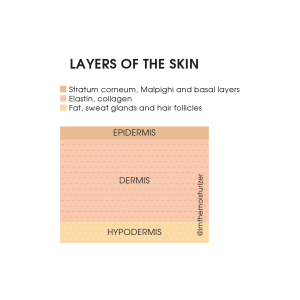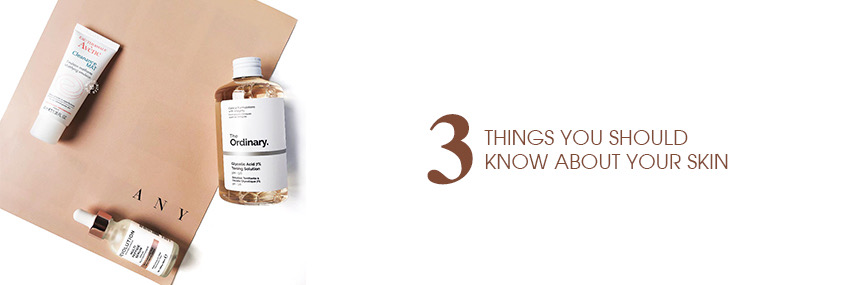How well do you know your skin? If you want a correct skincare routine you need to know your skin type and needs. On today’s guide you will learn about your skin, how to take care of it and why it’s important to have a proper skincare routine. Let’s learn a bit about ourselves!
Hello hello! You know I’ve been wanting for a while to make this blog serve as a starting point to start learning about the skin and better understand how it works, its needs, treatments you can use and everything that surrounds it. A few days ago, speaking with a reader, she told me that she would like to learn a little more about the most basic aspects of the skin, so I decided that it was time to share this post with you.
In this post I want to tell you about how our skin is. Do not be alarmed, I do not pretend to give a lesson in anatomy, far from it. I think it never hurts to remember a few things about what the skin is, what its layers are and how we can identify our skin types.
Specifically, in this post I will talk about the following topics:
1. Why is the skin so important?
2. What are the layers of the skin?
- Epidermis
- Dermis
- Hypodermis
3. What are skin types? How do I know my skin type?
- Normal skin
- Combination Skin
- Oily skin
- Dry skin
- Sensitive skin
1. WHY IS THE SKIN SO IMPORTANT?
The skin, as I have told you on some other times, is the largest organ of the human body. By now you must have read that a hundred times, but is skin really that important? Why is it worth caring for?
Our skin has many functions, but the most important are three: it protects us from external agents, helps us regulate body temperature and allows us to be in contact with the world around us. Of course, if we stop to think, we can realize that the skin serves us much more: it helps us absorb medicines that our body may need, helps us eliminate what we do not need through sweat, etc.
As I said in the first place, the skin helps us to protect ourselves from the external agents that we face every day. We do not realize it, but our skin is subjected to a constant battle against the world around us. Among others, the skin protects us from the following elements:
- Radiation: this word gives us a lot of fear, it makes us remember Chernobyl and catastrophes, but the reality is that everything (EVERYTHING) emits radiation. In short, radiation is nothing more than the emission of energy in the form of electromagnetic waves or subatomic particles. You emit radiation. Your computer emits radiation. The walls of your house emit radiation. Radiation itself is not dangerous. When we talk about the skin, we usually refer to its protective function of ultraviolet radiation, emitted by the sun and invisible to the human eye. Ultraviolet rays can be UVA, UVB and UVC. UVC rays, the most harmful, do not reach us, as they are absorbed by the ozone layer. UVB rays are the ones that tan us, but also those that produce burns and allergies and those that can lead to melanomas. Finally, UVA rays, which are the main cause of skin aging, are the most common, they constitute most of the ultraviolet radiation coming from the sun and they reach us throughout the year, even if the day is cloudy and through the windows.
- Temperature: I’m not going to turn on my weatherman mode, but it is logical that changes in temperature affect the skin. After all, when you go out into the street, your face is the first one that has to deal with the heat and the cold. If our skin is not well nourished and hydrated, changes in temperature can be even more damaging, contributing to dehydrate the skin. Over the years, in addition, the skin is increasingly sensitive to cold, heat and wind, as it weakens and these can cause more damage. It may seem obvious, but being well wrapped in winter and well protected in summer are key to our skin does not suffer so much with the weather.
- Hits and scratches: if you’re as clumsy as me, you know what I’m talking about. I do not know about you, but I am constantly hitting myself, I have a magnet that attracts all the corners, allowing me to have a nice leopard print throughout the year. Now seriously, if it were not for the skin, all those little bumps and scratches would be much more damaging to our body.
- Infections: stop and think, for a minute, about the amount of microorganisms that come into contact with your body on a daily basis. Bacteria, viruses, fungi and other microorganisms that roam our world, often find our skin, which protects us through its own microbioma and prevents them from accessing our body. If it were not for her, we would be much more vulnerable to diseases.
See, I have only focused on the most elementary protective functions of the skin, but if it were not for her we would be unprotected against many threats, don’t you think that is enough reason to take good care of it? But wait, there’s more… the skin also helps us regulate body temperature. Sweating is essential to maintain the thermal balance of our body. If it were not for it, every time we have a fever our temperature would unbalance and a simple flu could end up killing us. Or, when the temperature goes down a lot, if we could not warm our skin, the temperature of our body would also decrease and we could easily enter hypothermia. With this I do not intend to become hypochondriac, but I think it is important to be aware of how important it is that the skin allows us to have a stable temperature all day and all year.
I want to finish this section with one of the most important (and nicest) functions of the skin. If it were not for the skin, we could not be in contact with the world in the same way that we are. The skin allows us to touch everything around us, learning which things are pleasant and which are unpleasant. It lets us know that we can be touching velvet for hours and that we should stop touching the hot coffee maker immediately. The receptors that exist throughout our body help us to know the world around us, allowing us to recognize shapes and textures without even needing to see things. Personally, I find it fascinating when I stop to think about it.
2. WHAT ARE THE LAYERS OF THE SKIN?

Although it may seem that the skin is a uniform organ, it is not like that. We all have heard or read about the epidermis, but there is much more. The skin is made up of three basic layers (from lesser to greater depth): epidermis, dermis and hypodermis (or subcutaneous tissue). In this post I do not want to give you an exhaustive analysis on each layer, the cell types that make it up, etc. (I think this is not the right place for that), but I think it’s good to have some basic knowledge on the subject to better understand how the treatments we use daily work. Also, you never know, maybe someday they ask you about this playing Trivial Pursuit and you want to leave everyone speechless.
Epidermis.
It is the outer layer of our skin, the first barrier against the world that surrounds us. It is formed by three other layers itself: the stratum corneum, the Malpighi layer and the basal layer. The stratum corneum is the outermost part of the epidermis, made up of a series of layers of dead cells that make up the surface of the skin. In its outermost part, the stratum corneum has what is known as the hydrolipidic barrier or acid mantle: an emulsion of water and oil that helps maintain a stable pH level and prevent skin diseases. The deepest layer of the epidermis is made up of the germinative cells, which are those that renew the layers of the stratum corneum so that there is always an adequate proportion of cells that make it up. Finally, the Malpighi layer, which is located in the middle part of the epidermis, is made up of melanocytes, which are the cells responsible for protecting us from solar radiation.
Dermis.
It is the largest layer of our skin, it is the middle layer. It contains the blood vessels and capillaries that irrigate the cells of all our skin, the nerve endings that allow the skin to relate to the world around us (as we saw in the previous section) and the collagen and elastin fibers responsible to keep the skin smooth, firm and elastic.
Hypodermis
It is the deepest layer of the skin. In this layer the fat that accumulates in our body is stored, so you already know who to blame for those extra pounds. In addition, in the hypodermis we find the sweat glands (which allow us to expel water and toxins through sweat to regulate our temperature) and part of the hair follicles (where hair and body hair grow).
I am aware that it is a lot of information and very technical, but I have tried to synthesize as easily as possible what are the layers of our skin so you can better understand how it works.
3. WHAT ARE THE SKIN TYPES? HOW DO I KNOW MY SKIN TYPE?
Very often we read articles that talk about your skin type, even I usually talk to you about the importance of using products that suit the needs of your skin type. In the first place, we must bear in mind that the skin type is not something as fixed and immovable as we usually think. Our skin can behave in different ways in different parts of the body (including the face). Even with the changes of temperatures and the passage of time it can also (and usually) change. Surely if you stop to think about it you realize that, perhaps, there are areas of your face with a greater tendency to get irritated and others with a greater tendency to oil. In fact, most of us have skin with a greater fat tendency in the T zone (forehead and nose) than in the rest of the face. However, we can notice certain tendencies (of a fairly generic nature) in our skin, so let’s see a little more in detail what it means to have sensitive, dry, oily skin, etc.
Normal skin.
Normal skin is the dream, the most desired, what we all seek. Normal skin is one that has a balance that does not appear dry or oily, is soft to the touch and has a uniform tone. In general, normal skin is easy to identify when compared to other skin types, as you can see. Of course, normal skin does not mean that we can stop taking care of it or that we assume that it will remain that way constantly, since normal skin is the one that shows most the signs of age. If you have normal skin you should follow a strict beauty routine that helps you maintain that balance, without dehydrating or oilying the skin.
Combination skin.
Often those who have combination skin confuse it with oily skin, and they have several points in common. Those who have combination skin are characterized by having an oilier T-zone (remember, forehead and nose) and the rest of the face with normal (or sometimes dry) skin. To help mixed skin we must make a greater control of oil levels in the more oily areas, for example, with the local application of certain treatments such as masks or serums while we care, nourish and hydrate the rest of the face normally. An excess of cleansing on the whole face can lead to the oilier areas to remain unbalanced at the same time that the drier areas continue to dry. Remember, if your skin is mixed, the key is finding balance.
Oily skin.
Oily skin is one that has an excessive level of sebum, which leads to the usual presence of shine, large pores and black and white spots. There are many factors that contribute to a more oily skin and the presence of acne. Sometimes, dehydrated skin tends to be oilier, since in the absence of water the skin generates more oil to try to restore its balance and stay protected. Some of the factors that contribute to having more oily skin can be actively prevented, such as diet, proper beauty routines and good protection from the sun. Other factors, however, are more difficult to control, such as genetic and hormonal. I myself have oilier skin and I recognize that having a strict beauty routine adapted to my needs has been a fundamental step when it comes to improving my appearance. Often, those who have oily skin tend to think that the solution is to wash it non-stop, but an excess of cleansing (as well as an excess of exfoliation) will only bring us the most undesirable result, since the skin will continue to be unbalanced and, therefore, we will continue contributing to those shines and spots that we like so much.
Dry skin.
Dry skin tends to have a greater tendency to feel rough and tight, it is possible that flaking appears and sometimes it even causes itching. Dry skin may appear as a consequence of external factors such as those mentioned above: increase and decrease of temperatures, changes of seasons, solar radiation, etc. In addition, we ourselves can contribute to a greater dryness of the skin with an excess of washing and exfoliation or using an inadequate routine. In addition, it is interesting to mention that, sometimes, dry skin, as a result of its lack of balance in its oil levels, can lead to greater sensitization, so it is important to try to maintain it nourished. To help dry skin to be maintained, nourished and hydrated it is important to maintain a good beauty routine, respecting all the steps and being strict at the time of performing it morning and night, as I have mentioned in previous posts.
Sensitive skin.
Sensitive skin isn’t a skin type but a condition that is characterized by a greater tendency to irritations and redness. Those who have the most sensitive skin usually find more problems when using certain acids (such as, for example, those with a greater component of vitamin C or AHA -Alpha Hydroxy Acids, such as glycolic acid and malic acid- and BHA -Beta Hydroxy Acids, like salicylic acid-), as well as products that incorporate fragrances (I’ve already talked in more depth about this topic in this post) In general, the more sensitive skins are should rather use neutral products, without perfumes or dyes, to avoid possible negative reactions.
In this post I have tried to contribute my bit to help you know yourself better and be able to identify your skin type. I know I could have gone deeper into the more technical aspects, but I think it is better to give you some more generic brushstrokes here and, later on, if you want me to continue, I will do it. In any case, you know that you can leave me a comment with any questions you have and I will answer as soon as possible.
And you, have you been able to identify what your skin type is?
Did you like this post? Do you want to learn new tips on beauty, cosmetics and skin care? Then you will like to read these others:
Do you want to learn to take better care of your skin? You can see an index of all my informative posts here.● Follow me on Instagram, Facebook, TikTok and Pinterest.
● Share, comment and like my posts on social media.
● Shop through my links to help me keep up with this blog.

I’m Nacho and I’m passionate about skincare. I really enjoy learning and sharing my knowledge about skincare and I read scientific papers so you don’t have to. I want to break stereotypes because I believe skincare has no gender: skin is skin.


